Spatial Assessment of Para Rubber (Hevea brasiliensis) above Ground Biomass Potentials in Songkhla Province, Southern Thailand
Abstract
:1. Introduction
2. Materials and Methods
2.1. Study Area
2.2. Land Cover and Landuse Assessment
2.3. Net Primary Productivity Assessment and Validation
2.4. Above Ground Biomass Potentials Estimation
3. Results
3.1. Land Cover, NDVI, and EVI Distribution in Songkhla Province
3.2. Net Primary Productivity Distribution in Songkhla Province
3.3. Para Rubber Land Use and Biomass Characteristics
3.4. Different Pools of Para Rubber above Ground Biomass Potentials in Songkhla Province
4. Discussion
5. Conclusions
Author Contributions
Funding
Institutional Review Board Statement
Informed Consent Statement
Data Availability Statement
Acknowledgments
Conflicts of Interest
References
- Vongkhamheng, C.; Zhou, J.; Beckline, M.; Phimmachanh, S. Socioeconomic and Ecological Impact Analysis of Rubber Cultivation in Southeast Asia. OALib 2016, 3, 1–11. [Google Scholar] [CrossRef]
- Arias, M.; Van Dijk, P. What Is Natural Rubber and Why Are We Searching for New Sources. Front. Young Minds 2019, 7. [Google Scholar] [CrossRef] [Green Version]
- Ali, S.; Taweekun, J.; Techato, K.; Waewsak, J.; Gyawali, S. GIS Based Site Suitability Assessment for Wind and Solar Farms in Songkhla, Thailand. Renew. Energy 2019, 132, 1360–1372. [Google Scholar] [CrossRef]
- Heuze, V.; Tran, G.; Boval, M.; Maxin, G.; Lebas, F. Congo Grass (Brachiaria Ruziziensis). Feedipedia, a Programme by INRA, CIRAD, AFZ and FAO; 2017. INRA, CIRAD, AFZ and FAO: Paris, France. Available online: https://www.feedipedia.org/node/251 (accessed on 15 December 2019).
- Krukanont, P.; Prasertsan, S. Geographical Distribution of Biomass and Potential Sites of Rubber Wood Fired Power Plants in Southern Thailand. Biomass Bioenergy 2004, 26, 47–59. [Google Scholar] [CrossRef]
- Narongsak Jaisamut. The Director of the Rubber Authority of Thailand’s Production Development Department; An Interview with Nikkei Asian Review Media; The Nation: Bangkok, Thailand, 2018. [Google Scholar]
- Gonçalves, A.C.; Sousa, A.M.; Mesquita, P. Functions for Aboveground Biomass Estimation Derived from Satellite Images Data in Mediterranean Agroforestry Systems. Agrofor. Syst. 2019, 93, 1485–1500. [Google Scholar] [CrossRef] [Green Version]
- Næsset, E. Practical Large-Scale Forest Stand Inventory Using a Small-Footprint Airborne Scanning Laser. Scand. J. For. Res. 2004, 19, 164–179. [Google Scholar] [CrossRef]
- Lu, D.; Chen, Q.; Wang, G.; Liu, L.; Li, G.; Moran, E. A Survey of Remote Sensing-Based Aboveground Biomass Estimation Methods in Forest Ecosystems. Int. J. Digit. Earth 2016, 9, 63–105. [Google Scholar] [CrossRef]
- Eisfelder, C.; Kuenzer, C.; Dech, S. Derivation of Biomass Information for Semi-Arid Areas Using Remote-Sensing Data. Int. J. Remote Sens. 2012, 33, 2937–2984. [Google Scholar] [CrossRef]
- McRoberts, R.E.; Tomppo, E.O.; Næsset, E. Advances and Emerging Issues in National Forest Inventories. Scand. J. For. Res. 2010, 25, 368–381. [Google Scholar] [CrossRef]
- Thai Meteorological Department. Yearly Statistics Data Classfied by Year. Southern Eastern; 0051 Hat Yai Weather Observation Station. Available online: http://www.aws-observation.tmd.go.th/web/climate/climate_past.asp (accessed on 18 May 2020).
- Hytönen, J.; Nurmi, J.; Kaakkurivaara, N.; Kaakkurivaara, T. Rubber Tree (Hevea Brasiliensis) Biomass, Nutrient Content, and Heating Values in Southern Thailand. Forests 2019, 10, 638. [Google Scholar] [CrossRef] [Green Version]
- Chantuma, A.; Kunarasiri, A.; Chantuma, P. Rubber New Planting in Thailand: Towards the World Affected on Climate Change. Rubber Thai J. 2012, 1, 40–47. [Google Scholar]
- Samart, S. Power Plant to Fulfill the Dream to Be ‘Energy City’. The Nation Newspaper, 4 August 2015; 7. [Google Scholar]
- MAPASYST. What Does Vegetation Index Mean in Remote Sensing Technology? Available online: https://mapasyst.extension.org/what-does-vegetation-index-mean-in-remote-sensing-technology/ (accessed on 21 August 2019).
- Kumar, L.; Mutanga, O. Remote Sensing of Above-Ground Biomass. Remote Sens. 2017, 9, 935. [Google Scholar] [CrossRef] [Green Version]
- Gorelick, N.; Hancher, M.; Dixon, M.; Ilyushchenko, S.; Thau, D.; Moore, R. Google Earth Engine: Planetary-Scale Geospatial Analysis for Everyone. Remote Sens. Environ. 2017, 202, 18–27. [Google Scholar] [CrossRef]
- Sarkar, A. Accuracy Assessment and Analysis of Land Use Land Cover Change Using Geoinformatics Technique in Raniganj Coalfield Area, India. Int. J. Environ. Sci. Nat. Resour. 2018, 11, 25–34. [Google Scholar]
- USGS. Terra/MODIS Net Primary Production. Yearly L4 Global 1 km. Available online: https://lpdaac.usgs.gov/products/modis_products_table/mod17a (accessed on 4 March 2019).
- Running, S.; Mu, Q.; Zhao, M.; Moreno, A. MOD16A2GF MODIS/Terra Net Evapotranspiration Gap-Filled 8-Day L4 Global 500 m SIN Grid V006; VNASA EOSDIS Land Process; DAAC: Sioux Falls, SD, USA, 2019. [Google Scholar]
- DAAC, O. MODIS and VIIRS Land Products Global Subsetting and Visualization Tool. Available online: https://daac.ornl.gov/LAND_VAL/guides/MODIS_Global_C6.html (accessed on 15 March 2020).
- Penman, J.; Gytarsky, M.; Hiraishi, T.; Krug, T.; Kruger, D.; Pipatti, R.; Buendia, L.; Miwa, K.; Ngara, T.; Tanabe, K. Good Practice Guidance for Land Use, Land-Use Change and Forestry; Institute of Global Environmental Strategies: Kanagawa, Japan, 2003. [Google Scholar]
- Shufen, P.; Hanqin, T.; Shree, R.; Dangal, S.; Zhiyun, O.; Bo, T.; Wei, R.; Chaoqun, L.; Steven, R. Modeling and Monitoring Terrestrial Primary Production in a Changing Global Environment: Toward a Multiscale Synthesis of Observation and Simulation. Adv. Meteorol. 2014, 2014. [Google Scholar] [CrossRef]
- Jawjit, W.; Kroeze, C.; Rattanapan, S. Greenhouse Gas Emissions from Rubber Industry in Thailand. J. Clean. Prod. 2010, 18, 403–411. [Google Scholar] [CrossRef]
- Petsri, S.; Chidthaisong, A.; Pumijumnong, N.; Wachrinrat, C. Greenhouse Gas Emissions and Carbon Stock Changes in Rubber Tree Plantations in Thailand from 1990 to 2004. J. Clean. Prod. 2013, 52, 61–70. [Google Scholar] [CrossRef]
- Shi, X.; Elmore, A.; Li, X.; Gorence, N.J.; Jin, H.; Zhang, X.; Wang, F. Using Spatial Information Technologies to Select Sites for Biomass Power Plants: A Case Study in Guangdong Province, China. Biomass Bioenergy 2008, 32, 35–43. [Google Scholar] [CrossRef]
- Penman, J. Good Practice Guidance for Land Use, Land-Use Change and Forestry; IPCC National Greenhouse Gas Inventories Programme-Technical Support Unit: Hayama, Kanagawa, Japan, 2006. [Google Scholar]
- Liao, C.; Wu, C.; Huang, H. Study on the Distribution and Quantity of Biomass Residues Resource in China. Biomass Bioenergy 2004, 27, 111–117. [Google Scholar]
- TRY Summarized Records. Hevea Brasiliensis (Willd. ex A. Juss.) Müll. Arg. Encyclopedia of Life. Available online: https://www.try-db.org/TryWeb/dp.php (accessed on 15 July 2018).
- Wauters, J.-B.; Coudert, S.; Grallien, E.; Jonard, M.; Ponette, Q. Carbon Stock in Rubber Tree Plantations in Western Ghana and Mato Grosso (Brazil). For. Ecol. Manag. 2008, 255, 2347–2361. [Google Scholar] [CrossRef]
- Cheng, C.-M.; Wang, R.-S.; Jiang, J.-S. Variation of Soil Fertility and Carbon Sequestration by Planting Hevea Brasiliensis in Hainan Island, China. J. Environ. Sci. 2007, 19, 348–352. [Google Scholar] [CrossRef]
- Li, Z.; Fox, J.M. Mapping Rubber Tree Growth in Mainland Southeast Asia Using Time-Series MODIS 250 m NDVI and Statistical Data. Appl. Geogr. 2012, 32, 420–432. [Google Scholar] [CrossRef]
- Make a Database of Traits (MADtraits). (Willd. ex Juss.) Muell. Arg. record URL. Encyclopedia of Life. Available online: https://eol.org/data/R838-PK160366610 (accessed on 15 July 2018).
- Gnanavelrajah, N.; Shrestha, R.P.; Schmidt-Vogt, D.; Samarakoon, L. Carbon Stock Assessment and Soil Carbon Management in Agricultural Land-Uses in Thailand. Land Degrad. Dev. 2008, 19, 242–256. [Google Scholar] [CrossRef]
- Crop Ecological Requirements Database (ECOCROP). Hevea brasiliensis (Willd. ex A.Juss.) Müll. Arg. ECOCROP Was Designed with Relatively Basic Crop Environmental Requirements Information. Available online: http://www.fao.org/land-water/land/land-governance/land-resources-planning-toolbox/category/details/en/c/1027491/ (accessed on 15 November 2019).
- Bridhikitti, A. Soil and Biomass Carbon Stocks in Forest and Agricultural Lands in Tropical Climates. Songklanakarin J. Sci. Technol. 2017, 39, 697–707. [Google Scholar]
- Chave, J.; Coomes, D.; Jansen, S.; Lewis, S.L.; Swenson, N.G.; Zanne, A.E. Towards a worldwide wood economics spectrum. Ecol. Lett. 2009, 12, 351–366. [Google Scholar] [CrossRef] [PubMed]
- Tree Carbon Estimates Carbon Biomass. Hevea Brasiliensis (Willd. ex A. Juss.) Müll. Arg. above Ground Carbon Biomass Tree Carbon Estimates (tree_carbon_esti) Estimated from Wood Density and Plant Height Reports from Literature Sources. Available online: https://eol.org/data/R805-PK74274258 (accessed on 28 December 2018).
- Srichaichana, J.; Trisurat, Y.; Ongsomwang, S. Land Use and Land Cover Scenarios for Optimum Water Yield and Sediment Retention Ecosystem Services in Klong U-Tapao Watershed, Songkhla, Thailand. Sustainability 2019, 11, 2895. [Google Scholar] [CrossRef] [Green Version]
- Potter, C.; Klooster, S.; Genovese, V.; Hiatt, C. Forest Production Predicted from Satellite Image Analysis for the Southeast Asia Region. Carbon Balance Manag. 2013, 8, 1–6. [Google Scholar] [CrossRef] [Green Version]
- Richards, J.A. Supervised classification techniques. In Remote Sensing Digital Image Analysis; Springer: Berlin, Germany, 2013; pp. 247–318. [Google Scholar]
- Wang, R.; Chen, J.M.; Liu, Z.; Arain, A. Evaluation of seasonal variations of remotely sensed leaf area index over five evergreen coniferous forests. ISPRS J. Photogramm. Remote Sens. 2017, 130, 187–201. [Google Scholar] [CrossRef]
- Zhang, Y.; Xu, M.; Chen, H.; Adams, J. Global Pattern of NPP to GPP Ratio Derived from MODIS Data: Effects of Ecosystem Type, Geographical Location and Climate. Glob. Ecol. Biogeogr. 2009, 18, 280–290. [Google Scholar] [CrossRef]
- Potter, C.; Klooster, S.; Genovese, V. Net primary production of terrestrial ecosystems from 2000 to 2009. Clim. Chang. 2012, 115, 365–378. [Google Scholar] [CrossRef] [Green Version]
- Zhao, M.; Running, S.W. Drought-Induced Reduction in Global Terrestrial Net Primary Production from 2000 through 2009. Science 2010, 329, 940–943. [Google Scholar] [CrossRef] [PubMed] [Green Version]
- Kongmanee, C.; Ahmed, F. Detecting Trajectories in Rubber Farms in Southern Thailand. Int. J. Recent Technol. Eng. (IJRTE) 2019, 8, 633–642. [Google Scholar]
- Jha, N.; Tripathi, N.K.; Chanthorn, W.; Brockelman, W.; Nathalang, A.; Pélissier, R.; Pimmasarn, S.; Ploton, P.; Sasaki, N.; Virdis, S.G. Forest Aboveground Biomass Stock and Resilience in a Tropical Landscape of Thailand. Biogeosciences 2020, 17, 121–134. [Google Scholar] [CrossRef] [Green Version]
- Charoenjit, K. Estimation of Biomass and Carbon Stock in Para Rubber Plantation in East Thailand Using Object-Based Classification from THAICHOTE Satellite Data. Ph.D. Thesis, Université Pierre et Marie Curie-Paris VI, Paris, France, 2015. [Google Scholar]
- Bonner, M.T.; Schmidt, S.; Shoo, L.P. A Meta-Analytical Global Comparison of Aboveground Biomass Accumulation between Tropical Secondary Forests and Monoculture Plantations. For. Ecol. Manag. 2013, 291, 73–86. [Google Scholar] [CrossRef]
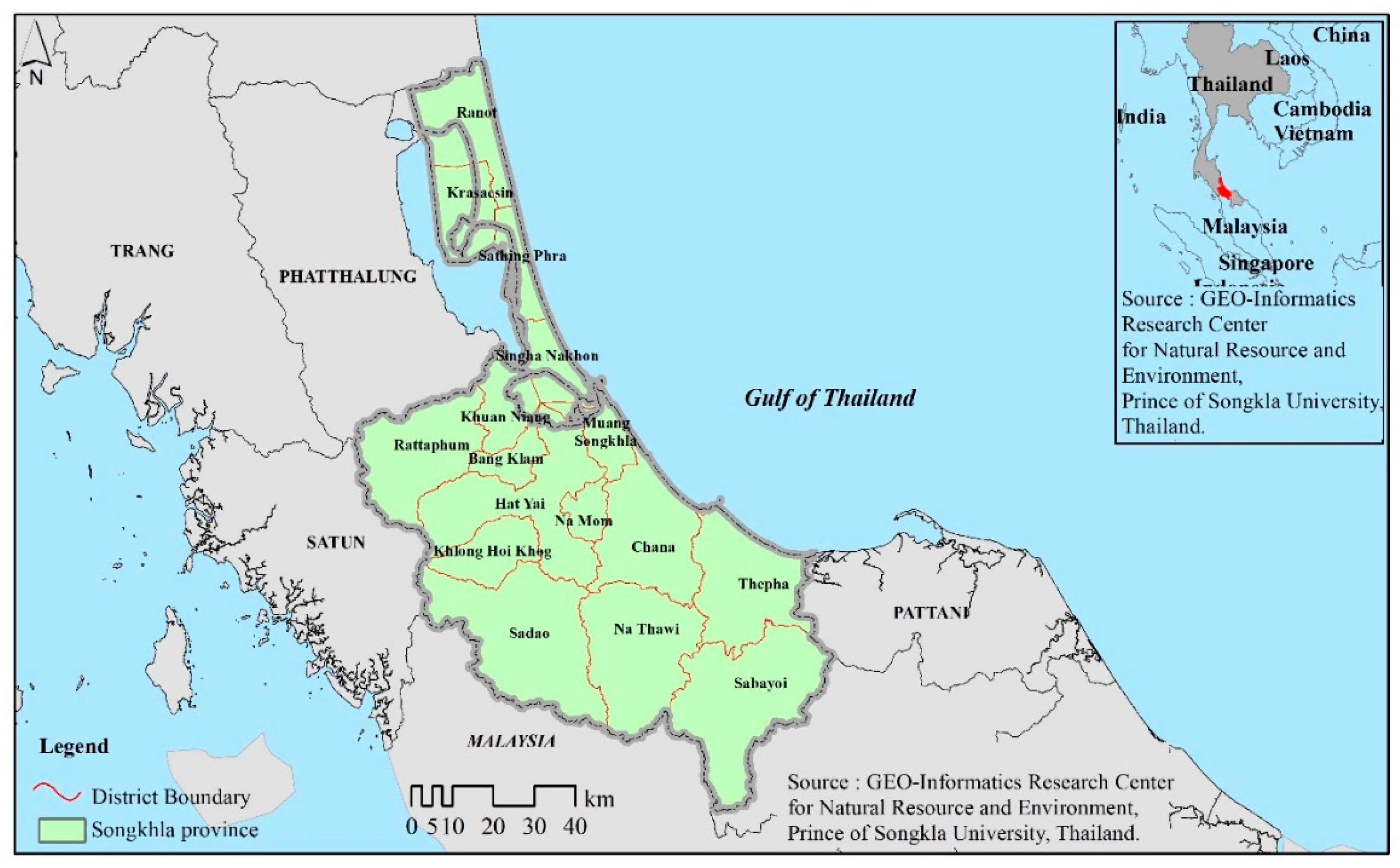
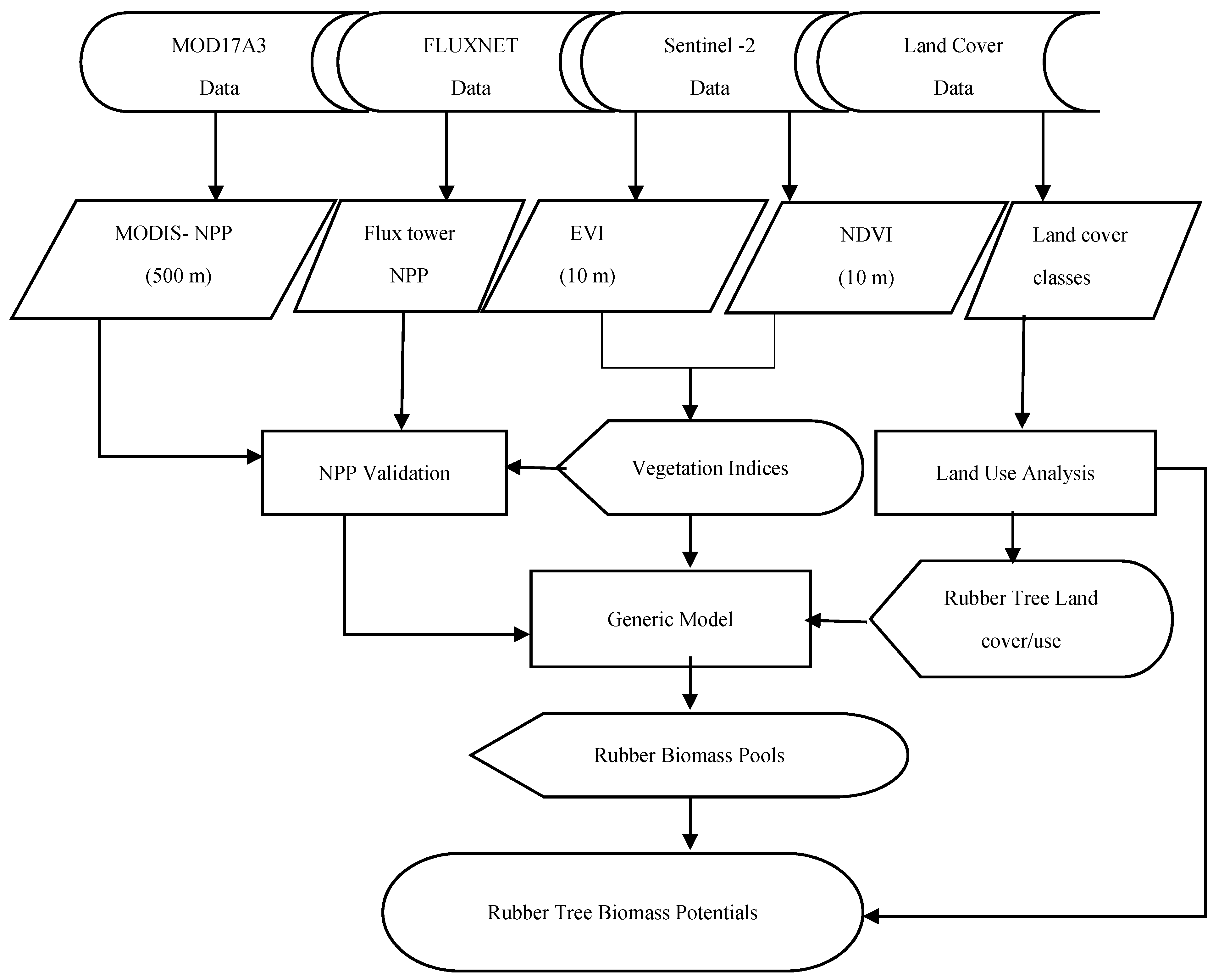
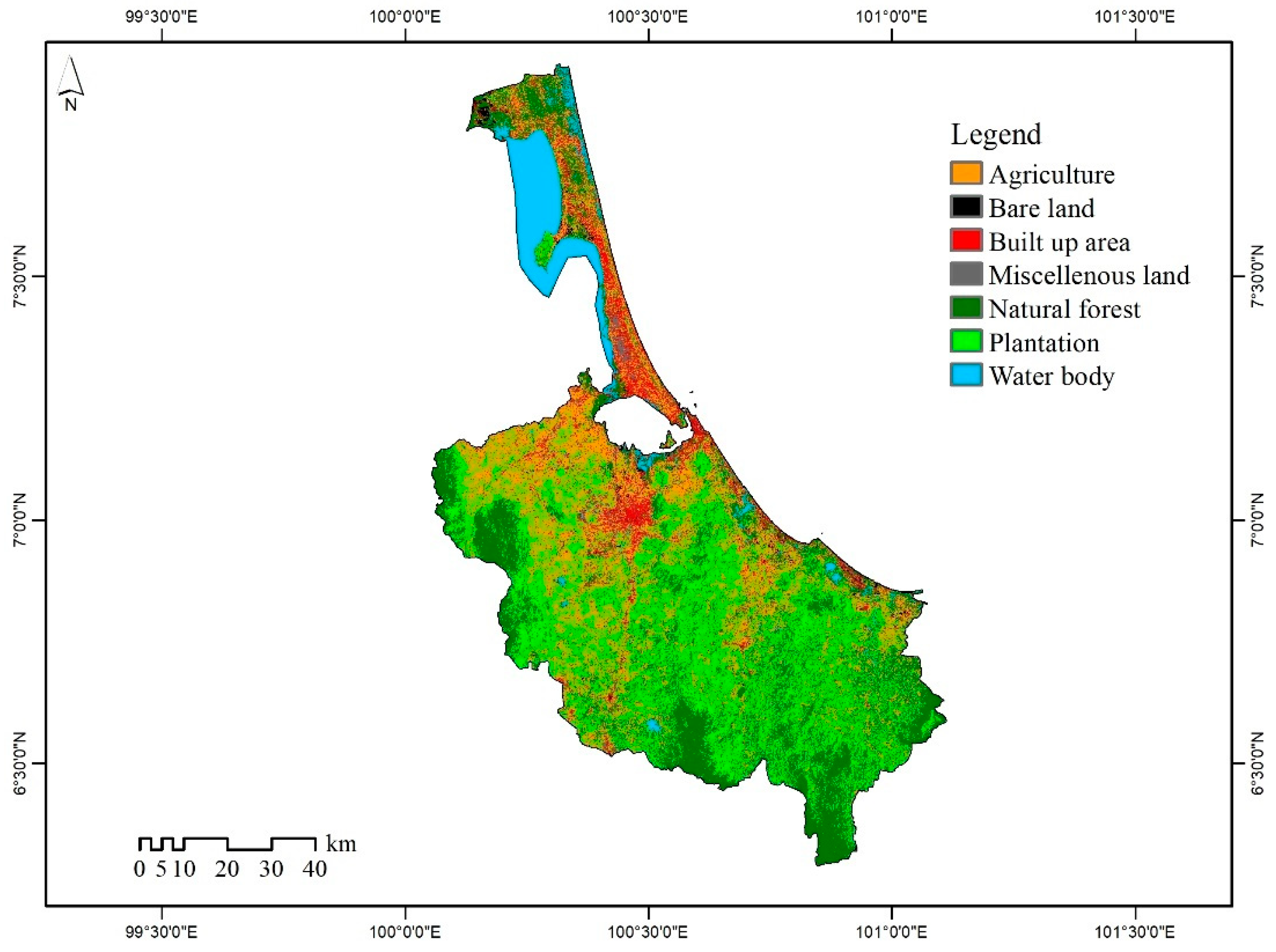

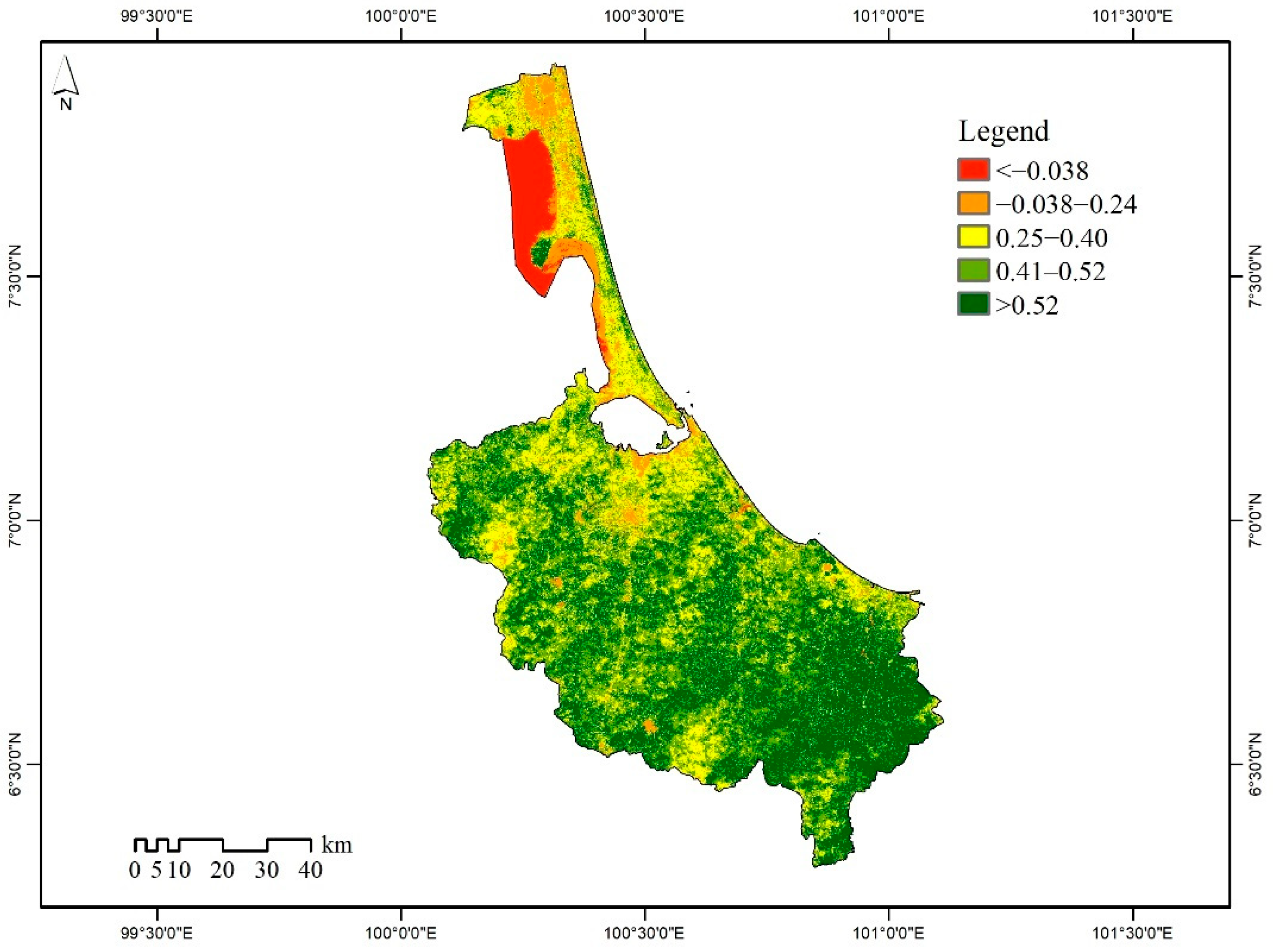
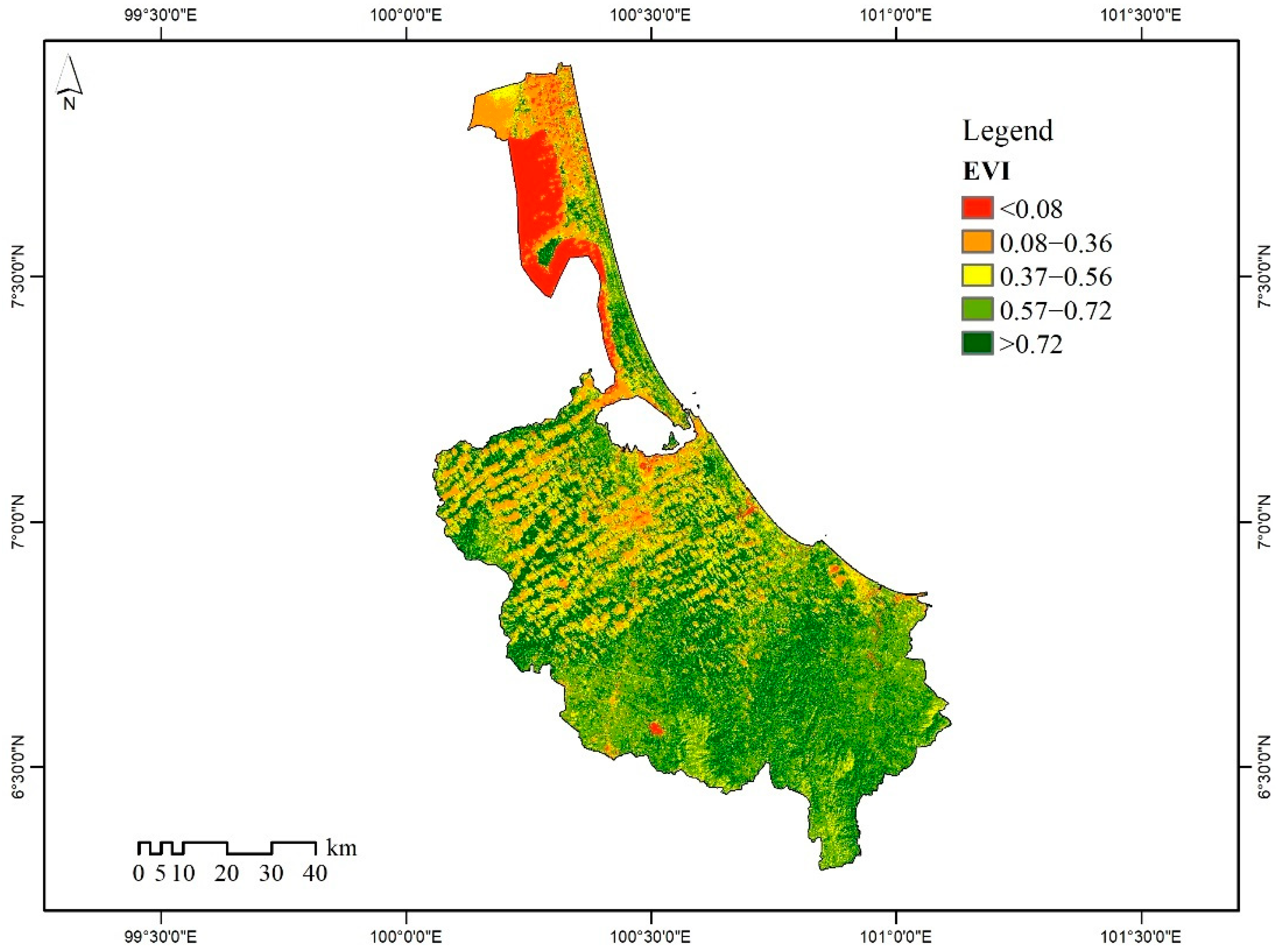
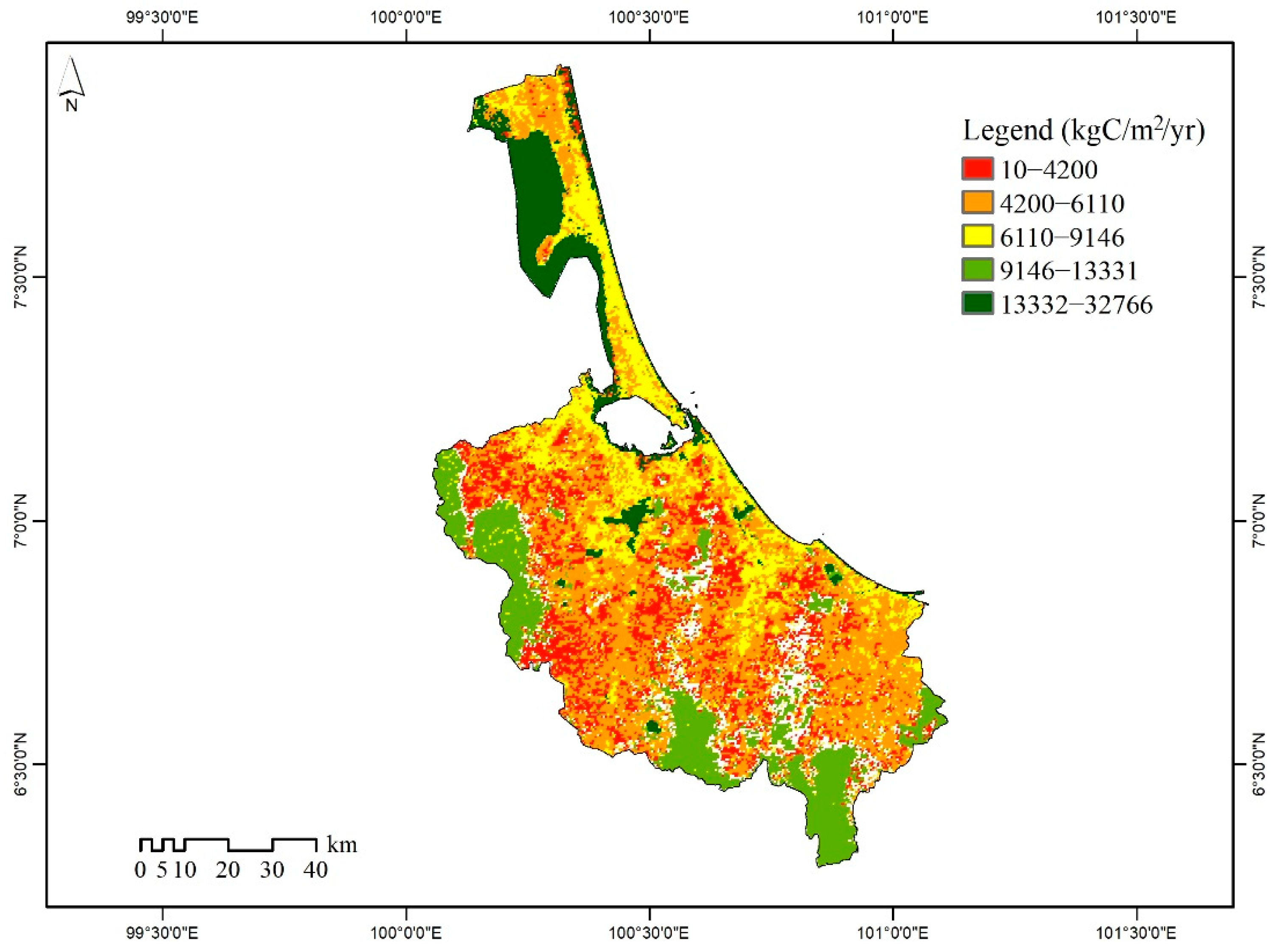
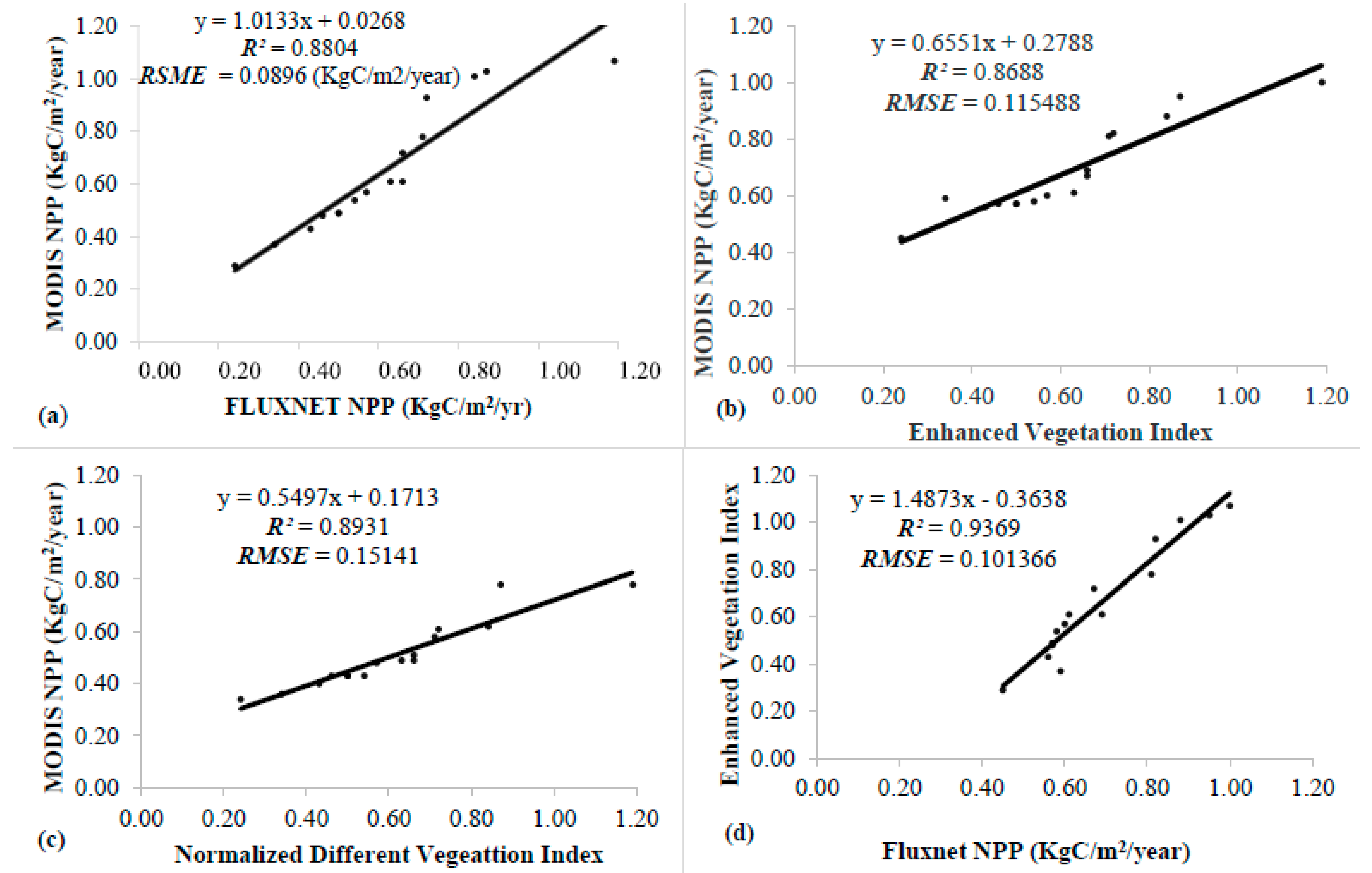
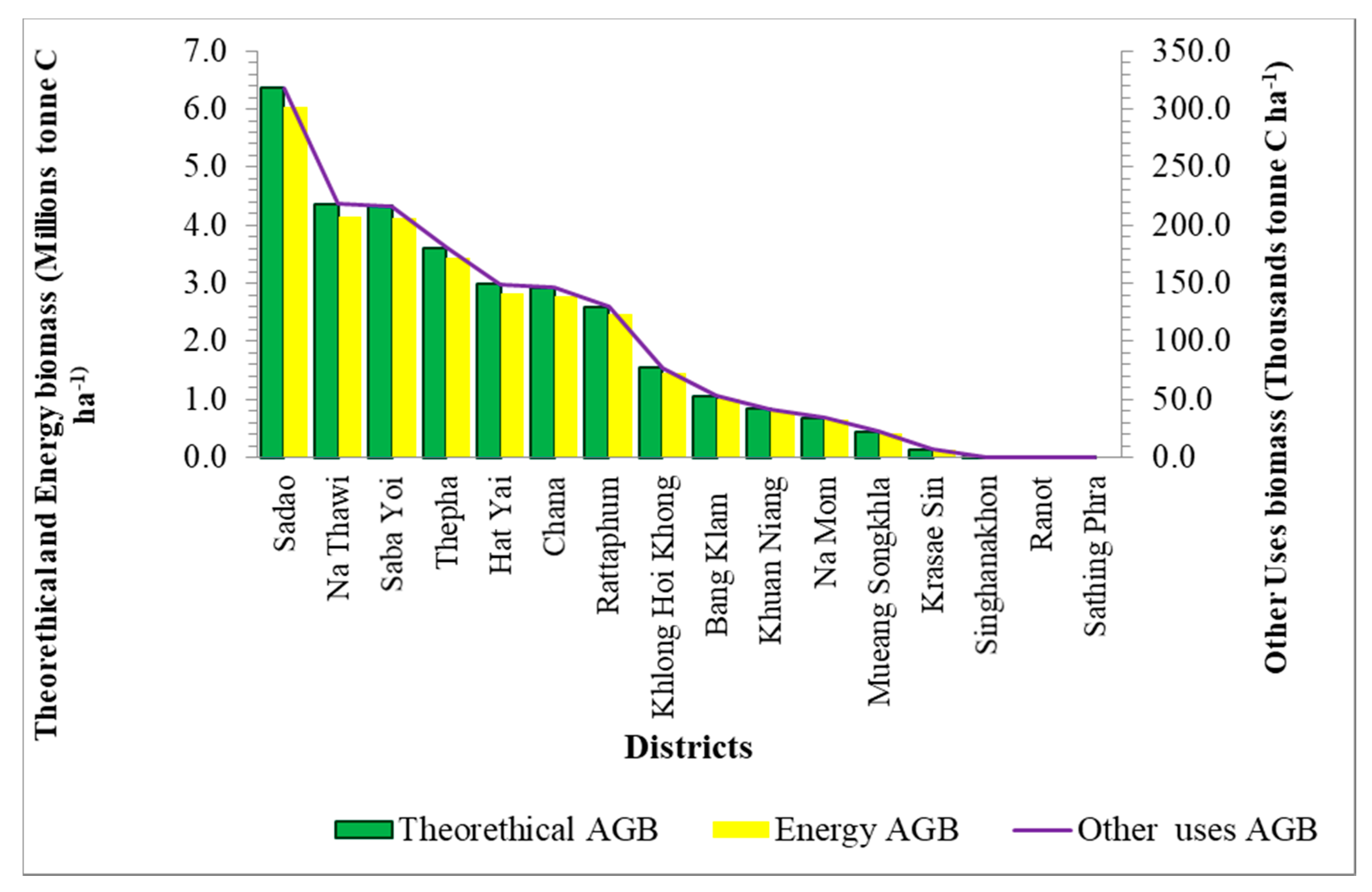
| Parameter | Algorithms |
|---|---|
| Overall Accuracy | (Total number of correctly classified pixels (diagonal))/(Total number of reference pixels) × 100 |
| Users Accuracy | (Number of correctly classified pixels in each category)/(Total number of classified pixels in that category (the row total)) × 100 |
| Producer Accuracy | (Number of correctly classified pixels in each category)/(Total number of reference pixels in that category (the column total)) × 100 |
| Kappa Coefficient (T) | ((TS × TCS)-∑ (column total × row total))/(TS2-∑ (column total x row Total)) × 100 TS (Total Sample) TCS (Total Corrected Sample) = Total Number of Correctly Classified Pixels |
| Site Name | Site ID | Coordinates | Network | Biome Type |
|---|---|---|---|---|
| Trang Khao Chong | th_trang_khao_chong | 99.7980 E, 7.5435 N | FORESTGEO | EBF |
| Songkhla | th_songkhla_songkhla_met_sta | 100.6046 E, 7.1844 N | AERONET | EBF |
| Sukhothani | th_sukhothai_mixed_vegetation_site | 99.4299 E, 16.9399 N | ASIAFLUX | DLC |
| Ubon Ratchathani | th_ubonratchathani_ubon_ratchathani | 104.8710 E, 15.2455 N | AERONET | DLC |
| Ratchaburi | th_ratchaburi_dry_dipterocarp_forest_flux | 99.5000 E, 13.5833 N | ASIAFLUX | DDF |
| Nakhon Pathom | th_nakhonpathom_silpakorn_univ | 100.0412 E, 13.8193 N | AERONET | EBF |
| Nakhon Nayok Mo | th_nakhonnayok_mo_singto | 101.3500 E, 14.4333 N | FORESTGEO | EBF |
| Kanchanaburi Mae | th_kanchanaburi_mae_klong | 98.8333 E, 14.5667 N | ASIAFLUX | MDF |
| Chiang Mai Omkoi | th_chiangmai_omkoi | 98.4317 E, 17.7983 N | AERONET | EBF |
| Chachoensao Rubber Flux | th_chachoengsao_rubber_flux_chachoengsao | 101.4414 E, 13.6656 N | ASIAFLUX | RFC |
| Singapore Bukit Timah | sg_bukit_timah | 103.7800 E, 1.3500 N | FORESTGEO | EBF |
| Negeri Sembilan Pasoh Forest Reserve | my_negerisembilan_pasoh_forest_reserve | 102.3062 E, 2.9730 N | ASIAFLUX FORESTGEO | EBF |
| Nong Khai Rubber Flux Bueng Kan | th_nongkhai_rubber_flux_bueng_kan | 103.3201 E, 18.2391 N | ASIAFLUX | RFC |
| Lampang Mae Moh | th_lampang_mae_moh | 99.7167 E, 18.4167 N | ASIAFLUX | DBF |
| Mandalay MTU | mm_mandalay_mtu | 96.1861 E, 21.9729 N | AERONET | DLC |
| Bac Lieu Bac Lieu | vn_baclieu_bac_lieu | 105.7300 E, 9.2800 N | AERONET | DLC |
| Land Cover | User’s Accuracy (%) | Producer’s Accuracy (%) | Overall Accuracy (%) | Kappa Coefficient | |
|---|---|---|---|---|---|
| Classified data | Natural Forest | 87.5 | 71.18 | ||
| Plantation | 80.51 | 68.88 | |||
| Agriculture | 75.29 | 49.61 | |||
| Built Up Area | 51.56 | 73.33 | |||
| Water Body | 91.37 | 92.98 | |||
| Bare Land | 35.41 | 89.47 | |||
| Miscellaneous Land | 45 | 85.71 | |||
| 68.81 | 0.63 |
| District | Number of Rubber Planting Communities | Number of Rubber Plantations per District | Plantation Size (Hectares) | Proportion of Rubber Land Use to Total Land Area (%) |
|---|---|---|---|---|
| Ranot | 7 | 11 | 48.1 | 0.1 |
| Sathing Phra | 6 | 8 | 20.8 | 0.2 |
| Singhanakhon | 7 | 17 | 80.3 | 0.4 |
| Krasae Sin | 3 | 28 | 1602.8 | 16.6 |
| Sadao | 9 | 644 | 77,441.5 | 75.3 |
| Hat Yai | 13 | 1149 | 36,313.1 | 42.6 |
| Saba Yoi | 9 | 843 | 52,790.3 | 61.9 |
| Na Thawi | 10 | 700 | 53,199.7 | 85.8 |
| Thepha | 7 | 570 | 43,952.3 | 44.9 |
| Chana | 14 | 975 | 35,657.2 | 70.9 |
| Na Mom | 4 | 221 | 8340.9 | 90.2 |
| Mueang Songkhla | 5 | 197 | 5453.0 | 31.7 |
| Khlong Hoi Khong | 4 | 411 | 18,781.4 | 68.3 |
| Bang Klam | 4 | 318 | 12,819.9 | 86.7 |
| Khuan Niang | 4 | 410 | 10,148.9 | 48.8 |
| Rattaphum | 8 | 1077 | 31,631.9 | 53.5 |
| Para Rubber Tree Description | Para Rubber Plantation AGB Estimations (Ground Assessments) | ||||
|---|---|---|---|---|---|
| Parameter | Trait | Source | Location | Estimated Biomass Carbon, Tonnes C ha−1 | Source |
| Name | Hevea brasiliensis ((Willd. ex Juss.) Muell) Arg. (Rubber tree) | [30] | Mato Grosso (Brazil) | 153 | [31] |
| Leaf Morphology | Broad | [30] | Western Ghana | 135 | [31] |
| Leaf Complexity | Compound | [30] | Hainan Island, China | 90.51 | [32] |
| Leaf Sheddability | Deciduous | [30] | Cambodia and Laos | 25–143 | [33] |
| Evergreen | [34] | ||||
| Life Cycle habit | Perennial | [30] | Agricultural lands in the eastern Coast of Thailand | 103.1 | [35] |
| Plant lifeform | Terrestrial Plant | [30] | Northeastern Thailand | 83.7 | [35] |
| Primary Growth form | Single Stem | [36] | |||
| Woodiness | Woody | [30] | The Rubber Research Center Buriram Thailand | 62.6 ± 27.4 | [37] |
| Vegetative plant height | 23 m | [30] | The PSU Research and Training | 91.5 ± 23.8 | [37] |
| Wood density | 0.49 g/cm3 | [38] | |||
| Diameter | 21.7 cm | [30] | Thepa Station, Songkhla Thailand | 62.6 ± 27.4 | [37] |
| Leaf mass per area | 100 g/m2 | [30] | |||
| Carbon biomass | 125 kg (average) | [39] | |||
Publisher’s Note: MDPI stays neutral with regard to jurisdictional claims in published maps and institutional affiliations. |
© 2021 by the authors. Licensee MDPI, Basel, Switzerland. This article is an open access article distributed under the terms and conditions of the Creative Commons Attribution (CC BY) license (https://creativecommons.org/licenses/by/4.0/).
Share and Cite
Simon, J.N.; Nuthammachot, N.; Titseesang, T.; Okpara, K.E.; Techato, K. Spatial Assessment of Para Rubber (Hevea brasiliensis) above Ground Biomass Potentials in Songkhla Province, Southern Thailand. Sustainability 2021, 13, 9344. https://doi.org/10.3390/su13169344
Simon JN, Nuthammachot N, Titseesang T, Okpara KE, Techato K. Spatial Assessment of Para Rubber (Hevea brasiliensis) above Ground Biomass Potentials in Songkhla Province, Southern Thailand. Sustainability. 2021; 13(16):9344. https://doi.org/10.3390/su13169344
Chicago/Turabian StyleSimon, John Nyandansobi, Narissara Nuthammachot, Teerawet Titseesang, Kingsley Ezechukwu Okpara, and Kuaanan Techato. 2021. "Spatial Assessment of Para Rubber (Hevea brasiliensis) above Ground Biomass Potentials in Songkhla Province, Southern Thailand" Sustainability 13, no. 16: 9344. https://doi.org/10.3390/su13169344






